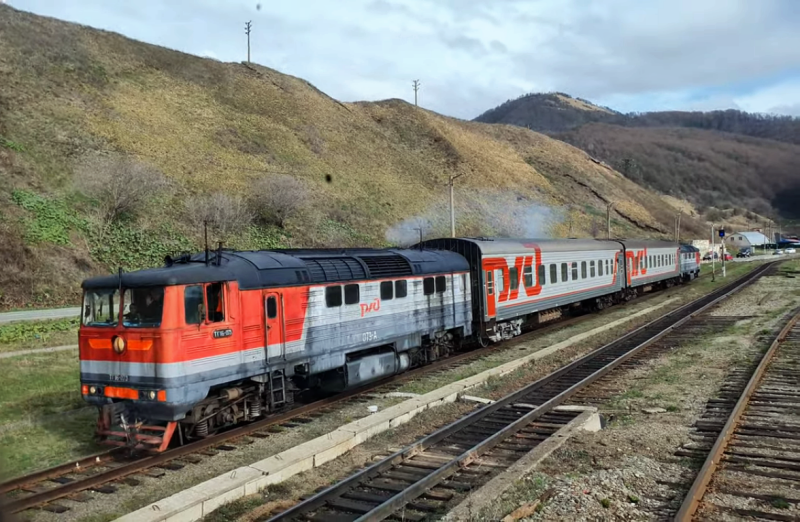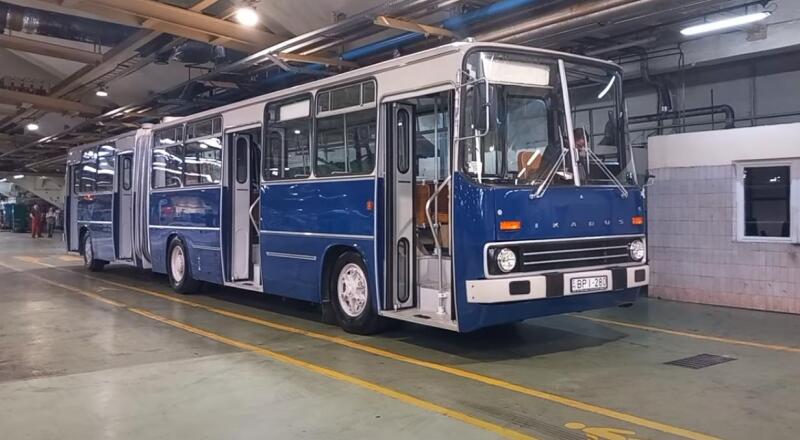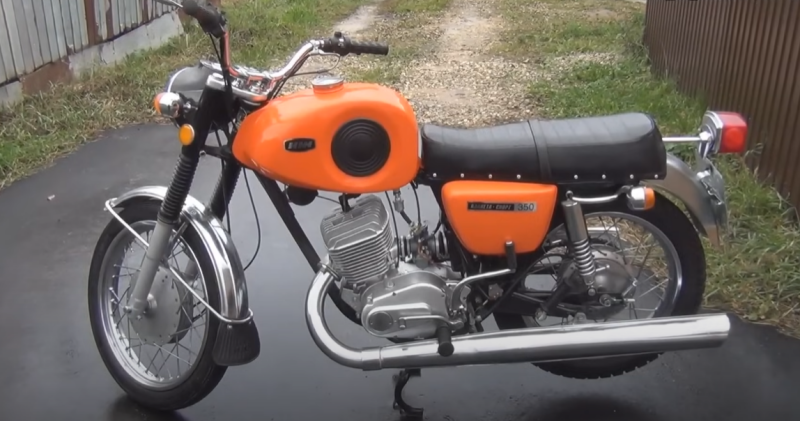In addition, there were also so-called. narrow gauge railways. These specific designs were used in such structures as access roads to industrial enterprises, remote areas or a children's railway. Having received a wide geographical distribution, they were still very rare and were gradually withdrawn from service.
 The latest narrow gauge diesel locomotives TG16. Photo: youtube.com
The latest narrow gauge diesel locomotives TG16. Photo: youtube.comIn this option, there was the fact of limited axle load and the total tonnage of the rolling stock. Therefore, the practicality of the lines looked very doubtful, which led to their gradual dismantling.
Especially for the Sakhalin narrow gauge railway
Until the end of the twentieth century, Sakhalin Island was distinguished not only by its remoteness from the main territory of the country. There was also specificity of a different kind. Being part of the Far Eastern Railway, the largest island in Russia had a structure of reduced width.
Passing along the east coast, it had a transverse size of only 1067 mm. The process of transition to a common standard started only in 2003, stretching until the start of the pandemic. All this helped eliminate the 10-fold increase in the cost of island transportation compared to continental transportation.
 Some TG16s are still running and doing the hard work. Photo: youtube.com
Some TG16s are still running and doing the hard work. Photo: youtube.comIt is not surprising that in the second half of the 60s, the USSR Ministry of Railways created an order for specialized enterprises to produce a special locomotive designed for narrow-gauge railways. At the same time, a special wish was its maximum power for operation in these conditions. The task of implementing the plan was entrusted to the specialists of the Lyudinovsky Diesel Locomotive Plant.
A prototype, created by the hands of LTZ workers, was presented in 1967. Primary wishes were taken into account by equipping the equipment with four 820-horsepower diesel engines.
.The power and running characteristics of the new narrow-gauge diesel locomotive turned out to be so optimally balanced that it was in operation for more than half a century, until the abolition of the 1067-mm railway on Sakhalin Island.
In addition to good performance, the locomotive was awarded an overly archaic design. He looked as if he had been born two or three decades earlier. But in remote areas this was not given much importance. Well, or almost not betrayed, because after all, the local railway workers gave him the slightly offensive nickname “Cleaver”. Here are its physical dimensions:
✅ height - 4 m
✅ width - 3 m
✅ section wheelbase – 11,25 m
✅ length of one section – 15,45 m
✅ full service weight – 148 t
As you probably already understood, the TG16 diesel locomotive was operated in a two-section version. Each part of the equipment was equipped with a pair of powerful M756A diesel engines. They performed quite well during operation, fully confirming the correctness of the designers’ choice. Here are the indicators of the power unit of a narrow gauge locomotive:
✅ total power – 3280 l. With
✅ type of transmission used – hydraulic
✅ design speed – 85 (for some modifications – up to 110) km/h
✅ total fuel reserve – 6,8 tons
The assembly of diesel locomotives was carried out at the main facilities of the enterprise for approximately seven years. During this period, about a hundred units of specific equipment were manufactured for the most remote Soviet road. Subsequently, it was operated in different areas, performing various tasks.
Option for regular gauge
To test the properties of a narrow-gauge diesel locomotive in action, the company decided to produce a locomotive designed for standard roads. After all, checking characteristics and correcting comments was possible only in specially created conditions. He received the name TG16-001 and went to work in the region of the northern capital.
 TG16 can also operate passenger flights. Photo: youtube.com
TG16 can also operate passenger flights. Photo: youtube.comAfter this locomotive passed the necessary checks, it was assigned to TC-9, belonging to the Oktyabrskaya Railway. It was here that his career began in 1972, which lasted about five years.
This technique differed from the standard version (except for the track size) in the diameter of the wheel pairs: 1050 mm instead of 950. Since the equipment was a prototype, made in a single copy, and also used for a very short period, this fact might not have been remembered at all.
However, thanks to the railway worker Andrei Voronov, who at one time worked as an assistant driver on this equipment, this became known to a wide circle of readers. The man also provided old photographs documenting the existence of such a rare locomotive.
The diesel locomotive was used at the Leningrad junction. His task was to ensure export work in this region. To operate on standard gauge, he needed sufficient engine power. The power units were the modernized M756B-1. Like its narrow-gauge counterpart, each section of the locomotive had a pair of such motors with a power of about 1000 hp. with each. Here are some of the characteristics of the experimental equipment:
✅ design speed – ok. 100 km/h
✅ proprietary hydraulic transmission on the frame
✅ cardan drive of wheelsets
Documentary photos show that TG16-001 worked in conjunction with other Soviet mainline diesel locomotives, in particular TE3. His exact fate is unknown due to the lack of any documentary information. According to unverified data, it was simply taken out of service already in 1977.
Long operation and the emergence of modern modifications
Until the end of the Soviet era and for a couple of decades of the post-Soviet period, TG16 successfully performed various tasks on the railway sections of Sakhalin Island. Since 2003, work began on the transition of local branches to the generally accepted track. But they dragged on for almost twenty years, which required the adoption of some temporary measures.
By the beginning of the 2010s, the old diesel locomotives began to noticeably lose their ground, and their archaic design looked too depressing. For this reason, it was decided to create several units of updated TG16M narrow-gauge locomotives, based on the old version.
 Modification of diesel locomotive TG16M. Photo: youtube.com
Modification of diesel locomotive TG16M. Photo: youtube.comOne of the outstanding characteristics of this technology was its ability to quickly “change shoes.” The specialists of the Lyudinovsky plant initially provided for this possibility so that the new diesel locomotives would not remain out of work over time, but could be used with the transition to 1520 mm gauge.
At the beginning of December 2014, the first machine arrived on Sakhalin, and eight months later a certificate of conformity for this equipment appeared. Despite the official approval, in practice the new diesel locomotive did not perform at its best. Breakdowns for this locomotive have turned from accidents into a system.
The situation was especially complicated by the fact that the operation site was as far away from the company’s production facilities as possible. This resulted in long-term downtime while waiting for the necessary spare parts to be delivered. Therefore, instead of the planned forty samples of the new modification, only six were assembled. So the total circulation of the TG16 series was exactly one hundred units.
 Externally, the TG16M diesel locomotive has been slightly modified. Photo: youtube.com
Externally, the TG16M diesel locomotive has been slightly modified. Photo: youtube.comBut the TG16M was operated on Sakhalin until 2021. After this, everyone's patience came to an end. A completely logical decision has matured to transfer them for further use on the basis of the Moscow Road. This brought the equipment as close as possible to the manufacturer of its spare parts. Half of the diesel locomotives even underwent major modernization, subsequently assigning them the TG16MK index.










